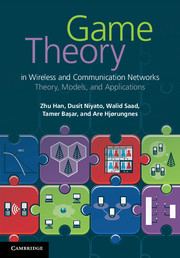Book contents
- Frontmatter
- Contents
- Preface
- 1 Introduction
- 2 Wireless networks: an introduction
- Part I Fundamentals of game theory
- Part II Applications of game theory in communications and networking
- 9 Cellular and broadband wireless access networks
- 10 Wireless local area networks
- 11 Multi-hop networks
- 12 Cooperative-transmission networks
- 13 Cognitive-radio networks
- 14 Internet networks
- References
- Index
12 - Cooperative-transmission networks
from Part II - Applications of game theory in communications and networking
Published online by Cambridge University Press: 25 October 2011
- Frontmatter
- Contents
- Preface
- 1 Introduction
- 2 Wireless networks: an introduction
- Part I Fundamentals of game theory
- Part II Applications of game theory in communications and networking
- 9 Cellular and broadband wireless access networks
- 10 Wireless local area networks
- 11 Multi-hop networks
- 12 Cooperative-transmission networks
- 13 Cognitive-radio networks
- 14 Internet networks
- References
- Index
Summary
Cooperative communication has attracted significant recent attention as a transmission strategy for future wireless networks. It efficiently takes advantage of the broadcast nature of wireless networks to allow network nodes to share their messages and transmit cooperatively as a virtual antenna array, thus providing diversity that can significantly improve system performance. Cooperative communication can be applied in a variety of wireless systems and networks. In the research community, a considerable amount of work has been done in this area for networks such as cellular, WiFi, ad hoc/sensor networks, and ultra wideband (UWB). These ideas are also working their way into standards; e.g., the IEEE 802.16 (WiMAX) standards body for future broadband wireless access has established the 802.16j relay task group to incorporate cooperative relaying mechanisms into this technology. Most existing work on cooperative communication concentrates on the physical (PHY) and medium access control (MAC) layers of wireless networks, examining issues such as capacity improvement, power control, and relay selection. The impact on the higher layers, such as routing in the network layer, has not been fully investigated yet.
The merits of cooperative transmission at the physical layer have been well explored. However, the impact of cooperative transmission on the design of the higher layers is not well understood yet. Specifically, the issues for various layers are:
Physical layer. Objectives include optimizing the capacity region, minimizing the bit error rate (BER), and improving the link quality by power control.
[…]
- Type
- Chapter
- Information
- Game Theory in Wireless and Communication NetworksTheory, Models, and Applications, pp. 375 - 417Publisher: Cambridge University PressPrint publication year: 2011



